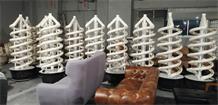

聯系電(diàn)話(huà)(微(wēi)信同步)
+86 187 4315 9877
+86 0431 83529333
聯系QQ
36173712
源食種植
Source foods cultivation
聯系我們 CONTACT US

地(dì) 址:吉林(lín)省農(nóng)安縣伏龍泉鎮大地(dì)家(jiā)園B棟
電(diàn) 話(huà):0431-83529333 18743159877
傳 真:0431-83529333
Q Q :36173712
郵 箱:info@sfgrow.com
熱線電(diàn)話(huà)
83529333
Greenhouse structures and all parts thereof shall be designed and constructed to safely support all
loads specified in this manual and the building code. These loads include the dead and live,
collateral loads, environmental loads and equipment loads specified by the purchaser.
The design of greenhouse structures, the load effect on the individual components and
connections shall be by rational engineering analysis methods. Rational engineering analysis is a
computational analysis, either by hand or computer, that uses accepted load distribution and
determination methods. Unusual structural and construction methods shall be based on
engineering analysis or physical testing by an approved laboratory.
Greenhouse structures shall be analyzed for all building code required load conditions. Elements
and components shall be designed for load combinations specified in the building code or
referenced standards.
Design Requirements
Prior to design the manufacturer should obtain local load information, i.e. wind, snow, etc.
Information should include:
Code of jurisdiction
Determination of loads:
• Roof Live Load
• Wind speed (3-second gust wind speeds)
• Snow load (ground snow load)
• Earthquake zone or design spectra
Soil type and allowable pressure
Required Information on Plans
Certain information must be shown on the construction drawings. The following information
shown below is required even if it is not a controlling design load. Information to be provided on
the plans includes:
• Dead Loads
• Roof Live Loads
• Collateral Loads (irrigation equipment, including water)
• Plant loads
• Snow Loads
Ground Snow Load pg
Flat-roof snow load, pf
Snow exposure factor, Ce
Snow load importance factor, Is
Thermal factor, Ct
• Wind Load
Basic wind speed (3 second gust), miles per hour
Wind importance factor, Iw and building category
Wind exposure category
Applicable internal pressure coefficient and prevailing wind direction
Design Wind Pressure on Components and cladding.
Exterior components and cladding materials are not specifically designed by the
Design Professional.
• Earthquake design data
Seismic use group
Spectral response coefficients (SDS and SD1)
Site class
Basis seismic-force resisting system
Design base shear
Analysis procedure
• Flood load - If a building is located in a flood hazard area, established by a
jurisdiction having authority, the following shall be shown for areas not subject to
high-velocity wave action
Elevation of the lowest floor
Elevation to which any nonresidential building will be dry floodproofed
• Foundation Design
Reactions of structural elements when the foundation or other systems are to be
designed by others. If the structure is designed for future additions, the
foundation information should include the probable design load information.
Additions and alterations
Additions to existing greenhouses may be made. The new structure shall not make the existing
structure unsafe. The definition of unsafe and dangerous is included in the code or supporting
documents. For structural purposes it is related to the percent of overstress in structural members.
When a greenhouse is added to an existing building, the capability of the building to withstand
any loads superimposed by the greenhouse shall be verified including lateral loads due to
attachment and snow drift loads due to proximity.
Alterations may be made to any greenhouse if the new work complies with current code
provisions and any loads imposed on the existing structure do not create an unsafe condition.
Allowable stress design vs. strength design requirements - Design of typical greenhouse
structures may be made by using the allowable stress design (ASD) or the strength (LRFD)
design methods. The load combination equations used will depend on the design method. The
ASD is the most common approach used by most engineers for greenhouse structures.
Safety factors for greenhouse components - Safety factors for the structural members are
included in the code referenced standards.
Greenhouse classification (Code occupancy group under IBC 2000) - Greenhouse
structures may be considered an occupancy classification “U” when used as a Production
Greenhouse. Research facilities may be considered the same .Commercial greenhouse structures used for retail use are considered as a “B” or “M” occupancy
classification. This is based on the fact that the building is normally occupied.
Deflection and Drift - Deflection of greenhouse components are defined in IBC - Table
1604.3. There is no criteria limiting drift. The engineer should consider the serviceability
requirements of the building,